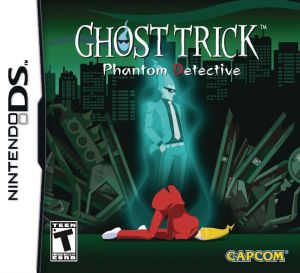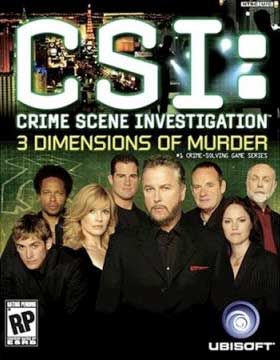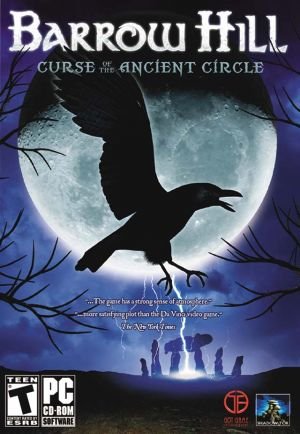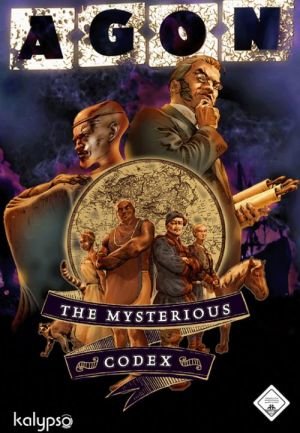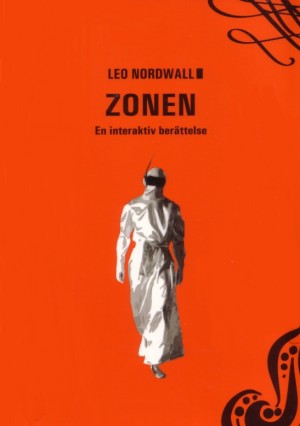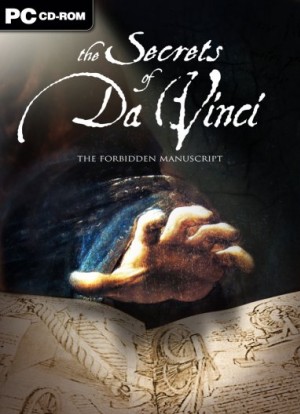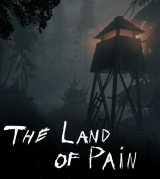Review for Ghost Trick: Phantom Detective

One of the things players dislike most in adventure games is meeting with an unexpected death. Eager to address this concern, Ghost Trick: Phantom Detective removes it entirely by starting just after the player character has died. In the latest handheld adventure from Ace Attorney creator Shu Takumi, players control a non-corporeal wraith who has just one night to solve the mystery of his sudden, violent death. Fortunately, the game proves a lot more substantial than its protagonist, featuring an excellent use of the DS touch screen, an intriguing story that keeps you guessing right to the end, and creative gameplay that is thoroughly pleasing, whether you are actively trying to solve a puzzle or simply tinkering with the many optional possibilities.
Early one evening, in a junkyard at the edge of an unnamed town, a man lies dead. With no memory of his past life or even how he came to die, a disembodied blue-flame spirit wakes to find, not only this sad sight, but also a hitman intending to add to the body count. At the prompting of a possessed desk lamp, the spirit discovers that he too can possess certain inanimate objects and use the titular ‘ghost tricks’ to control them. Warned that he will fade away with the coming of the dawn, our heroic ghost (soon identified as Sissel) sets out in a race against time to discover who he is and why he was killed.
Thus begins the story of Ghost Trick: Phantom Detective, and the subsequent tale reveals that there is a lot more at stake than the fate of one man. The story is split into eighteen chapters, each representing a small portion of your single night and each ending with new revelations, often overturning things you already thought you knew. This drip-feed of twists and turns in the plot spur you on to keep playing, as the solutions to early mysteries create even more mysteries to mull over. Whilst constantly throwing curveballs at you, the game is also full of plot hints of varying degrees of subtlety. These ensure that most of the revelations are “Now it makes sense!” moments rather than “Where the heck did that come from?” leaps of logic, making them all the more satisfying. The only downside to the story’s complexity is that events play out in a strictly linear fashion, forcing you to solve the puzzles in a set order.
Like the Phoenix Wright games, Ghost Trick has a wry sense of humour and is full of strange, larger than life characters. The hitman in the opening chapter is known as “Nearsighted Jeego”, a man who has never missed a mark, provided he gets to shoot at point-blank range. Elsewhere, a prison guard has to constantly write reminders for even his most basic duties, and performs his family’s traditional “Panic Dance” when things get out of control. Even Sissel himself, despite having no memory of his past, is visually striking in his bright red suit and sunglasses, with hair swept back to form a single huge blonde spike. With such striking qualities, characters could have easily ended up being defined solely by these exaggerated traits, but whilst this is true for some of the minor characters, the major characters all have more complex personalities that make them more realistic, despite their quirks.
Of course, a game needs enjoyable interaction as well, and Ghost Trick does not disappoint here either. After the opening cutscene, you are shown a standard real-world view of the junkyard, centred on where you died. Sliding the stylus around or using the +Control pad allows you to scroll the view to see the entirety of your current location. A quick tap of an on-screen button flips you over to the ghost world view of the same location. Here the touch screen changes to a stylised view of the same location, heavy filtered in red and largely blurring the details of the scene. Some objects are highlighted in blue with glowing dots, known as cores, somewhere within their outline. Sliding the stylus to a nearby core allows you to switch to that item to move around. The top screen displays a picture of the item you currently possess and the action you can perform with that item, if any. Returning to the living world and tapping the “Trick” button performs the associated trick. Initially these actions are directed to saving the young lady the hitman is pursuing, as she may represent the only lead for investigating your death. As the larger plot becomes clear, however, your personal quest takes a back seat as you begin to use your powers for the greater good.
There are a huge number of tricks available, ranging from simply opening a door to making ceiling fans spin at unsafe speeds and triggering emergency alarms. Your ability to move from object to object has a limited range, so working out how to reach places outside that range forms a significant part of many puzzles. This does not mean they are repetitive, though, as the means of covering larger distances are as varied as the tricks. At the start, simply swivelling a lamp so it points in the direction you wish to go may be enough, but later puzzles involve trying to knock items off shelves into a gap otherwise too wide to bridge. You’ll eventually even try to direct the actions of the living, solely through external object manipulation.
Sometimes it is necessary to move quickly, such as when you push a button and need to leap to the door before it opens. This can prove annoying as you have to hit the “Trick” button and switch to the ghost world almost immediately. Timing is also an issue when you want to transfer to an object that moves independently, such as a motorised plane mobile. For these you need to switch to the ghost world just as the object reaches a point where you can jump to it. When the object is moving quickly, this can be tough to achieve. You also have the ability to trace telephone calls by possessing phones in use, which subsequently allows you to travel to any location traced. The simplicity of movement and trick operation, combined with the variety of results from a series of tricks, make even idle experimentation an effortless joy. Living world time is stopped while you are in the ghost world, so you always have plenty of time to view your options before moving into action.
To help you form a plan, small thought bubbles occasionally pop up on screen as well. Tapping these allows you to see Sissel’s thoughts on your current situation, which usually contain hints if you are stuck. These go some way towards overcoming the linearity issue, preventing your game from being entirely halted by an intransigent puzzle. Later in the game, you will periodically receive the aid of another spirit whose goals overlap with yours, a button available in both worlds allowing you to switch characters at will. This spirit has a different kind of power than Sissel, and both sets of abilities are needed to resolve their shared challenges, adding an extra level of complexity to the puzzles involved.
The most important trick of the game is one you will have to use again and again. If you possess the core of a recently dead person, you are able to converse with the spirit of the departed, then travel back four minutes before their death in order to save them. The deaths you find range from the relatively mundane (being shot) to the bizarre (being crushed beneath a giant artificial roast chicken). Rewinding time treats you to a cutscene depicting the last moments of the person’s life, giving the observant player plentiful clues on what might be done to alter their fate. You are then dropped back to the start of the sequence, where you must use your tricks to change history. The same controls are used in the past, but now you are operating against the clock, although flipping to the ghost world still gives you all the time you need to think. The four-minute duration is rather loosely applied, but the passage of time is marked by an hourglass that slowly loses its sand, along with intermittent displays of the flashback events briefly playing out. Whenever you are interrupted by one of these scenes, the game shows the location of your soul flame immediately afterwards, so you never lose track of where you are.
Timing is the key to many of these puzzles, with some things like the movement of a trolley being pushed by a waitress falling outside your control. Unlike the present, here a timing failure may put you in an unwinnable situation, but you are able to rewind to the start of the sequence once again at any time. You will often merely change rather than avert someone’s fate. These adjustments work as checkpoints that you can rewind to, and in all but one case I found it unnecessary to rewind further once these had been reached. This means that repeating a sequence never involves a long series of actions, which served to alleviate any frustration I felt when I made an error. Here again, thought bubbles provide hints, with a tick mark indicating when you have already viewed one in a previous attempt.
Once you have saved someone’s life, they permanently develop a core. Linking yourself to this core allows you to converse with their spirits to learn more of the plot. Conversations are presented through on-screen dialogue boxes with close-ups of the character speaking behind them. This same presentation is used for the many conversations you eavesdrop on throughout the game. Some spirit conversations simply follow a set course, but most include a list of subjects to discuss, with certain lines of enquiry adding to the list. Most are important to the story, with all topics needing to be covered before the narrative can progress. There is quite a bit of text to read overall, though the content is generally well written and therefore worth the effort. A tap on the touch screen advances conversations, allowing players to proceed at their own reading speed.
All this is backed up with great manga-inspired graphics. Despite the relatively small size of the DS screens, the developers have not skimped on the detail in the backgrounds, be it the grim stone walls of a prison or the opulence of an evil conspirator’s den. Even small objects such as tennis balls and individual leaves are shown, which is handy as some of them serve as parts of puzzles. Whilst still displaying a cartoon quality, the layered graphics of the backgrounds suggest a fully 3D world behind the 2D play area. Within buildings, this is further emphasised by being able to see the gaps in floors, the pipework and electrical cabling sometimes proving vital to your goals. The orange and blue silhouettes of characters and interactive items in the ghost world make it easy to spot objects that would otherwise be the cause of pixel hunts in the living world view.
Ghost Trick’s animation is also top-notch. A Special Investigations Unit inspector, whose style is better suited to the disco, performs a complicated series of dance moves to prepare for any major statement. This is all the more impressive the way his long coat and scarf move naturally around his flailing limbs as he does it. The environmental animations are equally well done, like a sedately spinning fan madly rocking from side to side when you turn up the speed. The beauty of these animations often made me try tricks just to see them play out, even when they didn’t advance my aims. The only place where the graphics are less detailed is in the close-ups during conversations, though even these are still easily recognisable, as the half-body figures come with a variety of poses and expressions that serve to convey the feelings of the speaker.
The soundtrack is also well done, with good use of repeated themes for particular locations and situations. The office of a uniformed justice minister has a militaristic tone, whereas ghost world conversations are backed by a slow haunting melody. Individual characters have their own themes as well, such as the joyful tune of Missile, a dog whose eagerness to protect his mistress is sorely hampered by being a small Pomeranian. The rewound death scenes have appropriately urgent music to remind you that time is of the essence, with an even more frantic version that plays in the closing seconds before death. In all cases, the music enhances the experience, without a single piece ever feeling out of place. The game is sadly unvoiced, but does feature a wealth of sound effects, such as the squeak of the turning desk lamp, the coughing of a sick little girl or the squealing tyres of a crashing van for additional atmosphere.
Having come up with an intriguing premise, it would have been all too easy for Capcom to cut corners beyond that, relying on the gimmick alone to garner sales. Thankfully, that is definitely not the case with Ghost Trick: Phantom Detective, which is a quality piece of work at every level. The controls are a joy to use, the game is pleasing to the eye and ear, the plot is never anything but intriguing and the gameplay is simply a joy to experience. At over 12 hours of play, it even delivers a decent game length. The requirement for a certain level of dexterity may put some people off, and it’s definitely lacking in free exploration, but what is on offer will more than offset that for most players. Overall, Ghost Trick is a fine addition to the list of quality adventure games on the DS, and I’d recommend DS owners aim to possess a copy as soon as possible.


